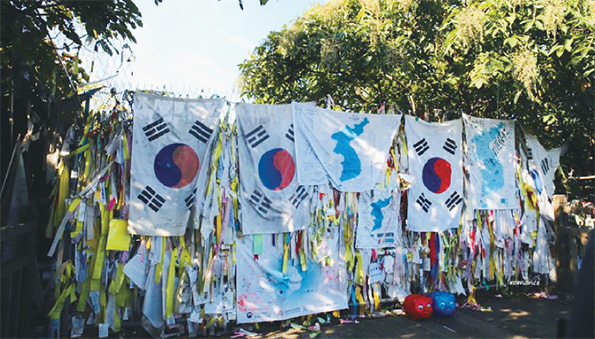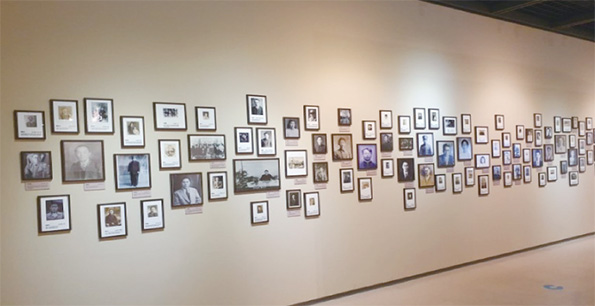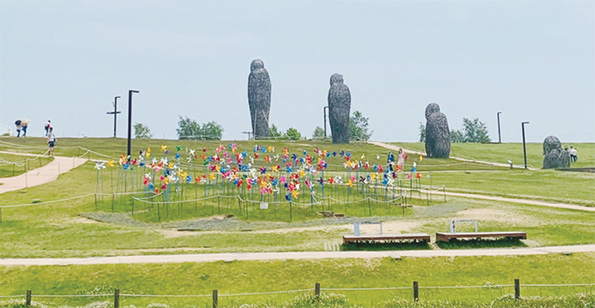
On June 25th 1950, the calm of the Korean Peninsula was suddenly interrupted by the screams of traumatized citizens at the fearful sight of the North Korean invasion. The Democratic People’s Republic of Korea, supported by the Soviet Union, invaded the Republic of Korea illegally. This was when neighbor turned against neighbor in a bloody civil war because of ideological conflict. This war has been known as ‘The Korean War’ and the 25th is designated as a national anniversary to commemorate the war. In this article, I’d like to introduce Imjingak; a place where you can experience the pain of division, and commemorate the Korean War.
Imjingak is located in Munsan-eup, Paju-si, Gyeonggi-do. It is a famous Unification Security Tourism Area made for North Korean displaced people in 1972. It is the nearest place to North Korea in South Korea. Despite it being a famous tourist destination, it was not easily accessible before. People could only go there by car or DMZ-Train (known as the peace train) making a round trip once a day only. However, people can visit much easier now because Imjingang Station was newly built on the Gyeong-ui Central Line. If you go there by subway, it is recommended to check the timetable carefully as the subway to Imjingang Station runs quite infrequently.
I could easily find Mangbaedan as soon as I got off the subway and entered the park. Mangbaedan is a monument made for displaced people from North Korea on September 26th, 1986. They hold ceremonies in front of the monument every year.
There was a Bell of Peace, next to Mangbaedan, which tolls to announce events every year. Every year, on the 31st of December, the Bell of Peace rings in the New Year.
There was also a train track behind the Mangbaedan and the Bell of Peace. Walking along the track, I could see a sign showing “Way to Seoul (53km)” and “Way to Gae-sung (22km).” I thought North Korea was far from there because North Korea is a different country. However, I was quite surprised that Gae-sung, located in North Korea, was closer than Seoul. At the end of this track, there was a Steam Locomotive at Jang-dan Station on Gyeong-ui Line, which is a railroad linking Seoul to Sinuiju. This Steam Locomotive was stopped by a bomb and derailed during the Korean War. When it was first found, it was said that a mulberry tree was growing on the train. The mulberry tree was displayed next to the Steam Locomotive. I felt heartache while watching the train, which was ragged, rusty, and scathed by the bomb.
After observing the train, I walked down to see a bridge. The bridge was named “The Bridge of Freedom” because more than 12,000 South Korean prisoners returned to South Korea and to freedom after the Armistice Agreement in 1953. At first, the Bridge of Freedom was the Gyeong-ui line railroad, but the bridge was destroyed by a bomb during the Korean War, so only a pier was left. It was restored for South Korean prisoners, and the bridge has remained “The Bridge of Freedom” until now. The bridge was blocked in the middle by a wall. The wall had inscriptions of people’s desire for reunification. I couldn’t go behind the wall because it was a civilian control area. Looking at the surrounding scenery on the bridge, I could see the Im-jin River on the left side and Dok-gae Bridge on the right.
Dok-gae Bridge was also destroyed by a bomb during the Korean War and rebuilt in the form of a railroad. This was also a civilian control area, so I could only enter after my identification card was confirmed and I paid the admission fee of 2,000₩ per adult. . Dok-gae Bridge was covered with glass, and I could see bullet marks on the bridge. After visiting the bridge, I found the Road of Freedom on the right side of Dok-gae Bridge. This road was also blocked because it was a civilian control area. Please note that you can’t take a picture of the surrounding area since it is military area.
I went to Pyeonughwa-nuri Park to rest. The weather was good and the wind was blowing gently, so I felt much better after looking around with a heavy heart. I sat on the “Hill of Wind” in Pyeonghaw-nuri Park. There were huge pinwheels at Hill of Wind, and a lot of people were taking photos. These pinwheels are works that express the hope that the free wind from South Korea will become the wind of peace and reach North Korea. The spinning pinwheels matched nicely with the blue sky and wind. Thus, you can also see a work called “Tongil-burugi.” This work is a sculpture of a person made of bamboo and steel bars. It symbolizes a low but strong hope for unification. If you go to Pyeonghwa-nuri Park, you can think about the meaning of pinwheels and take pictures.
The National Korean War Abductors Memorial Hall remembers those who were abducted by saving and displaying records of abductions to restore the honor of abductees and to console their families. There were a chandelier and hurricane shaped sculpture in the lobby. This sculpture was made up of the pictures of families of abductees before they were abducted, named “Into the hurricane.” It was displayed by LED, not by photos, and my heart was aching while watching the changing black-and-white photographs of abductees and their families.
Exiting the lobby, I went into an exhibition hall with various displays, for example, the background and cause of being kidnapped to North Korea, etc. First, I browsed the permanent exhibition hall on the 2nd floor. There was an exhibit expressing the difficulty of abductees’ families. It was a space that showed that their children, who were left, lived a difficult life after the abductees were kidnapped to North Korea. Even though I was just looking at the sculpture, the situation seemed real and I felt as if I was standing alone in that situation.
There was a Room of Memory where the abductees’ names were engraved. The walls of the room were completely covered with the names of 5000 people. It is said that abductions continued after the war and there were many cases where not only Korean fishing boats but also foreign fishing boats disappeared. I walked down the stairs to browse a special exhibition hall with a topic of ‘Last Family Picture.’ Abductees’ families were exhibiting relics and family pictures of them, which they kept for a long time. It didn’t hit me when I just saw the word “Last Family Picture,” but when I saw the pictures, which was only victims turned into white figures, I realized that it was the real “Last Family Picture” and my heart ached.
My Imjingak tour ended with the National Memorial Hall of the Korean War. It was a place where history was lurking close to the present. I saw the traces of the war with my own eyes and felt it with my heart, so it became more meaningful than when I just read about it in a textbook. Also, I could find that the pain of the Korean War has led to the pain of division by looking at the mailboxes installed here and there for separated families. We can live in peace now owing to our close ancestors’ sacrifice. We should always remember this fact, but we seem to easily forget about it. So as not to forget, I recommend that CBNU students go to Imjingak to ruminate over the meaning of the Korean War on June 25th.
By Ahn Min-joo l mj40@cbnu.ac.kr
By Ahn Young-tae l ytann05@cbnu.ac.kr
By Choi Jin-hyuk l jh41@cbnu.ac.kr


 All
All Experience
Experience






 Ahn Min-joo&Ahn Young-tae
Ahn Min-joo&Ahn Young-tae











